人教版七年级英语下册Unit5教学设计
- 格式:doc
- 大小:48.00 KB
- 文档页数:4
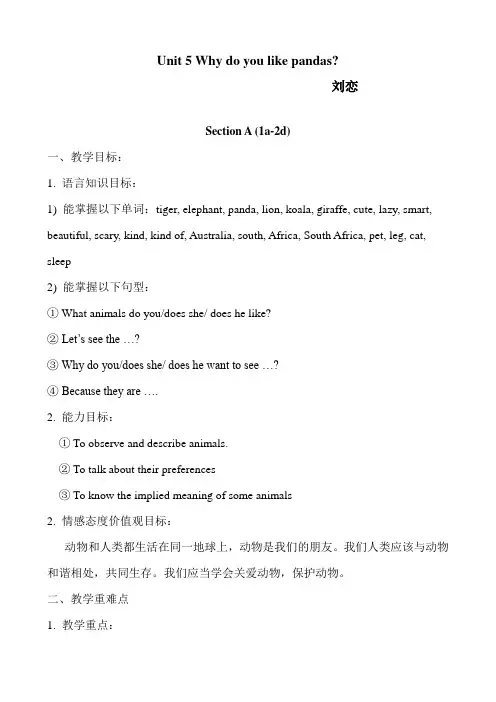
Unit 5 Why do you like pandas?刘恋Section A (1a-2d)一、教学目标:1. 语言知识目标:1) 能掌握以下单词:tiger, elephant, panda, lion, koala, giraffe, cute, lazy, smart, beautiful, scary, kind, kind of, Australia, south, Africa, South Africa, pet, leg, cat, sleep2) 能掌握以下句型:① What animals do you/does she/ does he like?②Let’s see the …?③Why do you/does she/ does he want to see …?④Because they are ….2. 能力目标:① To observe and describe animals.② To talk about their preferences③ To know the implied meaning of some animals2. 情感态度价值观目标:动物和人类都生活在同一地球上,动物是我们的朋友。
我们人类应该与动物和谐相处,共同生存。
我们应当学会关爱动物,保护动物。
二、教学重难点1. 教学重点:1) 学会描述动物的性格及特点。
2) 学会表达喜欢某类动物及说明喜欢的原因。
2. 教学难点:名词的复数形式表示一类事物;第三人称单数形式三、教学过程Ⅰ. Warming-up and lead inTo create an English environment, the teacher shows the class some pictures of a zoo. And ask some questions about animals:Do you like to go to the zoo?Do you like animals?Then have them to recall the animals they had learned and write them on the blackboard as he/she can.( e.g. animals---sheep, monkey, cat, dog, mouse, cow, duck… )Ⅱ. Presentation1. Ask them to talk with their partners about the animals they like using the words they know (Four students a group).—What animals do you like?—Why do you like…—Because they’re…2. Then show the class some pictures of animals and present other animals. And ask them:What’s this in English?It's a tiger. (Then lion, panda, elephant, koala, giraffe)Ss look at the picture and try to remember the new words of the animals.3. Next, glue the pictures on the blackboard and ask one student to match the pictures with the words on the cards. Other students turn to page 25 and finish 1a.4. Check the answers with the class.Ⅲ. Game (Guessing game.)T: Show some pictures on the big screen. Let Ss guess what animal it is.Ss try to guess and remember the names of the animals.Ⅳ. ListeningWork on 1b.Tell Ss to listen to the tape and check the animals they hear in 1a.Play the recording again and check the answers with the class.Ⅴ. Pair work1. Ask the students to imagine “ We are in the zoo, there are many kinds of animals here.”Then ask a student to do the model with you:—Let’s see the lions first.—Why? (why do you /does she /does he like lions?)—Because they are interesting.2. Ss work with their partners practice the conversation using the animal in 1a.Ⅵ. Listening1. Work on 2a;T: Listen to the conversation carefully. Then write the names of the animals you hear on these lines.Play the recording the first time. Students only listen.Play the recording a second time. This time students write in the names of the animals.Check the answers.Point out the adjectives and countries listed on the right. Ask a student to say the words.Say, Now I will play the recording again. This time draw a line between each animal and the adjective and countries you hear.Play the recording and have students match each animal with an adjective and a country.Correct the answers.2. Work on 2bT: Listen again and complete the conversation with the words in 2a.Play the recording for the Ss to listen and write the answers.Check the answers with the class.Ⅶ. Pair work1. Ask two students to read the conversation in 2b to the class.2. Ss practice the conversation in pairs.3. Then show the transcription on the big screen and practice the other two conversations in 2a.4. Ss practice the conversations in pairs.Ⅷ. Role-play1. Ask Ss to look at the picture in 2d. Then Ss read the conversation in 2d and findthe answers to the questions:① Does Peter have a pet?② What can Dingding do?③What pet does Jenny’s mom have?④ Does Jenny like the cat? Why?2. Ss read the conversations and try to find the answers to the questions.Check the answers:Yes, he does.He can walk on two legs. He can dance, too.She has a cat.No, she doesn’t. Because it’s very lazy.3. Ss work in pairs and practice the conversation.4. Let some pairs role-play the conversation.Homework:1. Remember the new words and expressions in this period.2. Role-play the conversation after class.3. Write the animal's names as many as possible in the exercises book.板书设计:Unit5 Why do you like pandans?Why don’t you +动词原形+其他Why not +动词原形+其他Let’s+动词原形Kind of 意为“稍微、有点”,用来修饰形容词,相当于a little a bit“Kinds of” 各种各样的“a kind of” 一种“different kinds of”不同种类的Unit 5 Why do you like pandas? Section A(1a-2d)说课稿教学内容分析:Section A(1a-2b)是unit5的第一课,主要学习一些关于动物的单词和一些形容动物的形容词,还有一些表达喜爱的句子!通过对话来进行课堂教学和语言实践。
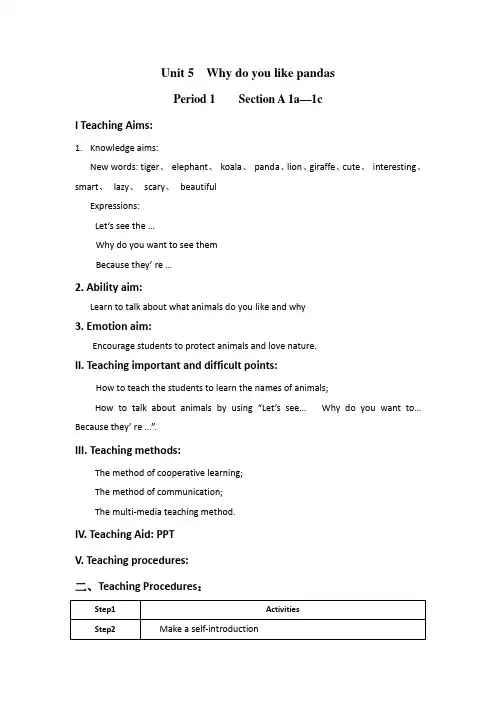
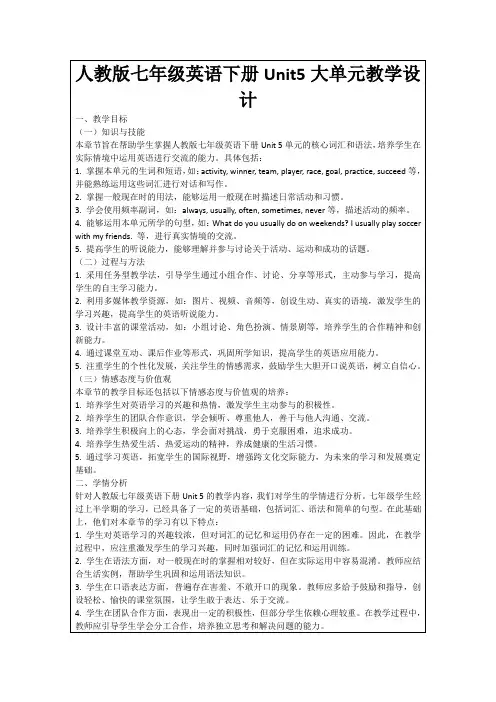

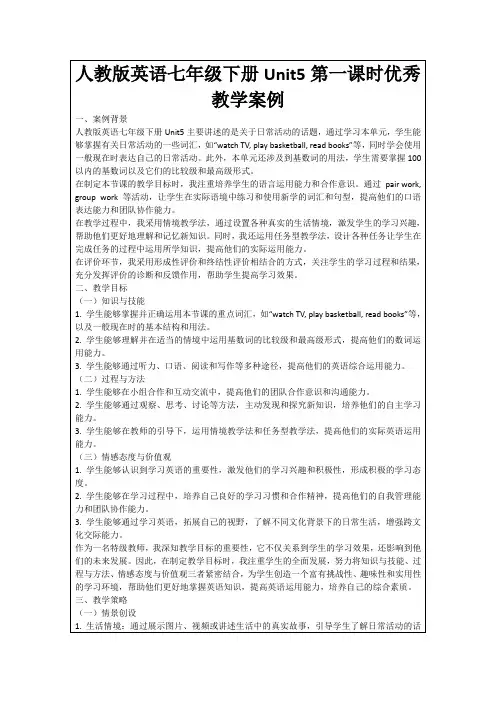

人教版新目标七年级英语下册 Unit 5 教案一. 教材分析人教版新目标七年级英语下册Unit 5主要讲述了日常生活中的一些活动,如游泳、打篮球、跳舞等。
本单元的话题贴近学生的生活,有利于激发学生的学习兴趣。
教材通过听说读写等多种活动,帮助学生掌握日常生活中的交际用语,提高学生的语言运用能力。
二. 学情分析七年级的学生已经掌握了基本的英语语法和单词,对于日常生活中的交际用语也有了一定的了解。
但部分学生可能在发音和口语表达上还存在困难,需要教师在教学中加以引导和纠正。
此外,学生可能对一些体育活动相关的词汇和表达不够熟悉,需要在课堂上进行拓展和练习。
三. 教学目标1.知识目标:学生能够掌握本单元的生词和短语,了解日常生活中的交际用语。
2.能力目标:学生能够听懂、会说、会读、会写与日常生活相关的英语句子。
3.情感目标:学生能够积极参与课堂活动,提高学习英语的兴趣。
四. 教学重难点1.重点:本单元的生词和短语,日常生活中的交际用语。
2.难点:情态动词can的用法,以及与日常生活相关的句型结构。
五. 教学方法1.任务型教学法:通过设置各种任务,让学生在完成任务的过程中学习英语。
2.情景教学法:创设各种生活情境,让学生在真实的环境中学习英语。
3.交际法:鼓励学生积极参与课堂交际,提高口语表达能力。
六. 教学准备1.准备单词卡片、短语卡片、图片等教学辅助材料。
2.准备与本单元话题相关的视频或音频材料。
3.准备课堂练习题和测试题。
七. 教学过程1.导入(5分钟)利用图片或视频引导学生谈论日常生活中喜欢的活动,引出本课话题。
2.呈现(10分钟)老师展示本课的生词和短语,让学生朗读并解释其意思。
同时,老师用情态动词can提问,引导学生回答。
3.操练(15分钟)学生分角色扮演,用情态动词can进行问答。
老师巡回指导,纠正发音和表达错误。
4.巩固(10分钟)学生完成课堂练习题,老师及时批改和讲解。
5.拓展(5分钟)老师引导学生谈论更多关于日常活动的表达,如游泳、打篮球、跳舞等。

Unit 5 Why do you like pandas?Section A (1a-2d)一、教学目标:1. 语言知识目标:1) 能掌握以下单词:tiger, elephant, panda, lion, koala, giraffe, cute, lazy, smart, beautiful, scary, kind, kind of, Australia, south, Africa, South Africa, pet, leg, cat, sleep2) 能掌握以下句型:① What animals do you/does she/ does he like?②Let’s see the …?③Why do you/does she/ does he want to see …?④Because they are ….2. 能力目标:① To observe and describe animals.② To talk about their preferences③ To know the implied meaning of some animals2. 情感态度价值观目标:动物和人类都生活在同一地球上,动物是我们的朋友。
我们人类应该与动物和谐相处,共同生存。
我们应当学会关爱动物,保护动物。
二、教学重难点1. 教学重点:1) 学会描述动物的性格及特点。
2) 学会表达喜欢某类动物及说明喜欢的原因。
2. 教学难点:名词的复数形式表示一类事物;第三人称单数形式三、教学过程Ⅰ. Warming-up and lead inTo create an English environment, the teacher shows the class some pictures of a zoo. And ask some questions about animals:Do you like to go to the zoo?Do you like animals?Then have them to recall the animals they had learned and write them on the blackboard as he/she can.( e.g. animals,sheep, monkey, cat, dog, mouse, cow, duck… )Ⅱ. Presentation1. Ask them to talk with their partners about the animals they like using the words they know (Four students a group).—What animals do you like?—Why do you like…—Because they’re…2. Then show the class some pictures of animals and present other animals. And ask them:What’s this in English?It's a tiger. (Then lion, panda, elephant, koala, giraffe)Ss look at the picture and try to remember the new words of the animals.3. Next, glue the pictures on the blackboard and ask one student to match the pictures with the words on the cards. Other students turn to page 25 and finish 1a.4. Check the answers with the class.Ⅲ. Game (Guessing game.)T: Show some pictures on the big screen. Let Ss guess what animal it is.Ss try to guess and remember the names of the animals.Ⅳ. ListeningWork on 1b.Tell Ss to listen to the tape and check the animals they hear in 1a.Play the recording again and check the answers with the class.Ⅴ. Pair work1. Ask the students to imagine “ We are in the zoo, there are many kinds of animals here.”Then ask a student to do the model with you:—Let’s see the lions first.—Why? (why do you /does she /does he like lions?)—Because they are interesting.2. Ss work with their partners practice the conversation using the animal in 1a.Ⅵ. Listening1. Work on 2a;T: Listen to the conversation carefully. Then write the names of the animals you hear on these lines.Play the recording the first time. Students only listen.Play the recording a second time. This time students write in the names of the animals. Check the answers.Point out the adjectives and countries listed on the right. Ask a student to say the words. Say, Now I will play the recording again. This time draw a line between each animal and the adjective and countries you hear.Play the recording and have students match each animal with an adjective and a country. Correct the answers.2. Work on 2bT: Listen again and complete the conversation with the words in 2a.Play the recording for the Ss to listen and write the answers.Check the answers with the class.Ⅶ. Pair work1. Ask two students to read the conversation in 2b to the class.2. Ss practice the conversation in pairs.3. Then show the transcription on the big screen and practice the other two conversations in 2a.4. Ss practice the conversations in pairs.Ⅷ. Role-play1. Ask Ss to look at the picture in 2d. Then Ss read the conversation in 2d and find the answers to the questions:① Does Peter have a pet?② What can Dingding do?③What pet does Jenny’s mom have?④ Does Jenny like the cat? Why?2. Ss read the conversations and try to find the answers to the questions.Check the answers:Yes, he does.He can walk on two legs. He can dance, too.She has a cat.No, she doesn’t. Because it’s very lazy.3. Ss work in pairs and practice the conversation.4. Let some pairs role-play the conversation.Homework:1. Remember the new words and expressions in this period.2. Role-play the conversation after class.3. Write the animal's names as many as possible in the exercises book.板书设计:Section A (Grammar Focus-3c)一、教学目标:1. 语言知识目标:1) 继续练习运用如何做描述动物及表述自己对动物的喜好。

人教版英语七年级下册《Unit 5 Why do you like pandas?》教学设计【教材分析】人教版英语七年级下册Unit 5 Why do you like pandas? 本单元的主题是通过谈论动物来熟练运用“why—because”句型提出疑问,解决问题。
通过对本单元的学习,学生能够对动物的性格及自己对动物的喜好的原因进行交流表达,并能够熟练运用“why—because”句型来询问他人的爱好,解释原因。
通过对动物的描述,让学生从从潜意识意识到动物的重要性,让学生自觉的爱护动物,保护动物,进而激发学生对大自然的保护意识,有利于帮助学生树立环保意识,增强环保观念。
【学情分析】我校地处城乡结合部,班级学生是以中等生为主的七年级新生,他们学习英语有很大的学习兴趣,有较强的记忆力和模仿能力,并有较强的求知欲和表现欲,因此课堂教学中我尽量让他们参与到活动中来,让他们有更多的机会来说英语用英语。
通过小组合作学习,体验自主学习的成功和喜悦。
【学习目标】1.知识与技能:A. 能掌握单词friendly shy及句型What animals do you like? I like elephants.B. 让学生学会谈论简单的动物及名称以及对动物的喜欢并说明为什么喜欢动物。
2.过程与方法:充分利用教材和多媒体教学所提供的学习资源,实现自由参与和创新,能主动与他人交流,在鼓励性评价中树立信心,在小组活动中积极参与合作,从而意识到交流对于学习英语的重要意义。
3.情感态度与价值观:通过本课学习,使学生有兴趣听说英语、做游戏,敢于开口,乐于模仿,恰当使用英语谈论简单的动物及名称以及对动物的喜欢并说明为什么喜欢动物,激发学生学习英语兴趣和保护环境的意识。
教学重点:让学生学习用形容词描述动物,从而说明自己喜欢某种动物的原因。
教学难点:让学生用句型What animals do you like? Why do you like ......? Because they are cute.等句型编对话。

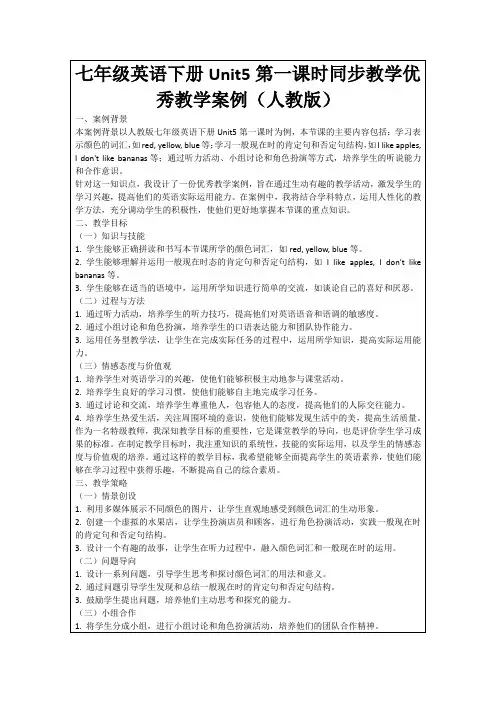

人教版七年级下册英语Unit 5 说课稿一. 教材分析人教版七年级下册英语Unit 5主要讲述了日常生活中的一些活动,如做家务、上学、看电影等。
本单元的核心词汇有housework, homework, watch, read, sports 等,同时本单元还涉及到一般现在时的用法。
通过本单元的学习,学生能够掌握日常生活中的一些基本表达,并能用英语描述自己的日常活动。
二. 学情分析七年级的学生已经具备了一定的英语基础,能够进行简单的英语交流。
但是,部分学生对于一般现在时的用法还不是很清楚,需要老师在教学中进行详细的解释和引导。
此外,学生在口语表达方面还存在一定的困难,需要老师提供更多的机会进行实践和锻炼。
三. 说教学目标1.知识目标:学生能够掌握Unit 5中的核心词汇和短语,理解一般现在时的用法。
2.能力目标:学生能够用英语描述自己的日常活动,进行简单的交流。
3.情感目标:通过学习,学生能够培养对英语的兴趣,增强学习的自信心。
四. 说教学重难点1.重点:学生能够掌握Unit 5中的核心词汇和短语,理解一般现在时的用法。
2.难点:学生能够运用一般现在时描述自己的日常活动,并进行口语交流。
五. 说教学方法与手段1.教学方法:采用任务型教学法,让学生在实际操作中掌握知识,提高能力。
2.教学手段:利用多媒体课件、图片、卡片等辅助教学,增加课堂的趣味性。
六. 说教学过程1.导入:通过展示图片,引导学生谈论自己喜欢的活动,引出本课主题。
2.新课呈现:通过多媒体课件,展示本课的核心词汇和短语,讲解一般现在时的用法。
3.操练:学生分组进行角色扮演,运用一般现在时描述自己的日常活动。
4.巩固:学生完成课堂练习,检测对知识的掌握情况。
5.拓展:引导学生谈论自己的梦想,用英语表达对未来生活的期望。
6.总结:对本课内容进行总结,强调一般现在时的用法。
七. 说板书设计板书设计如下:人教版七年级下册英语Unit 5核心词汇:housework, homework, watch, read, sports等一般现在时:主语 + 动词原形八. 说教学评价1.课堂参与度:观察学生在课堂上的参与情况,是否积极回答问题,参与讨论。
人教版新目标七年级英语下册 Unit 5 教学设计一. 教材分析人教版新目标七年级英语下册Unit 5主要围绕日常生活话题,通过学习本单元,学生能够掌握日常生活中的一些基本表达方式,提高他们的口语交际能力。
本单元的主要内容包括:询问和描述日常活动、表达喜好和意愿、谈论过去和将来的计划等。
本节课的主要目标是让学生能够熟练运用一般现在时进行日常交流。
二. 学情分析七年级的学生已经掌握了基本的英语语法和词汇,对日常生活中的常用表达有一定的了解。
但是,他们在口语表达和听力理解方面还存在一定的困难。
因此,在教学过程中,需要注重培养学生的口语交际能力和听力理解能力。
三. 教学目标1.能够熟练运用一般现在时进行日常交流。
2.能够听懂并正确回答关于日常活动的问题。
3.能够描述自己的喜好和意愿。
4.能够谈论过去和将来的计划。
四. 教学重难点1.一般现在时的运用。
2.日常英语表达的准确性。
3.听力理解的提高。
五. 教学方法采用交际法、任务型教学法和情境教学法。
通过设定真实的语境,让学生在实际交流中掌握语言知识,提高他们的口语交际能力和听力理解能力。
六. 教学准备1.教材:人教版新目标七年级英语下册。
2.教学多媒体课件。
3.教学卡片。
4.录音机和录音带。
七. 教学过程1.导入(5分钟)通过与学生谈论他们的日常活动,激发学生的学习兴趣,引导学生进入学习状态。
2.呈现(10分钟)利用多媒体课件和教学卡片,展示本节课的主要内容,让学生初步感知和理解。
3.操练(15分钟)通过小组活动和角色扮演,让学生在实际交流中运用所学知识,提高他们的口语交际能力。
4.巩固(10分钟)通过听力练习和口语交流,让学生进一步巩固所学知识,提高他们的听力理解能力。
5.拓展(10分钟)让学生谈论自己的喜好和意愿,以及过去和将来的计划,提高他们的语言运用能力。
6.小结(5分钟)对本节课的主要内容进行回顾和总结,让学生明确所学知识。
7.家庭作业(5分钟)布置作业:让学生运用一般现在时写一篇关于自己日常活动的短文。
人教版初中英语七年级下册Unit5Why do you like pandas?Section A (2d-3c)教师姓名:济南市【课题】Unit5 Why do you like pandas? Section A (2d-3c)✧课标内容1.能描述各种常见的动物。
2.能表达自己对动物的喜好。
✧课标分解✧教学目标【知识与技能】1、掌握四会单词及词组:panda, zoo, tiger, elephant, lion, giraffe, koala, scary, smart,beautiful, lazy, cute, kind of2、能正确使用why, what和where 引导的特殊疑问句进行回答。
掌握基本的句型:A: Why do you like pandas? B: Because they’re kind of interesting.A: Where are lions from? B: They’re from South Africa.A: Why don’t you like tigers? B: Because they’re scary.3、能正确使用表示性质和品质的形容词。
Your dog is really cute.He’s very smart.She’s kind of boring.4、能简单的运用本节课学习的知识表达自己对动物的喜好以及原因。
【过程与方法】1、通过Competition ,把全班分成两队,形成对抗,对上一节课的知识进行复习和巩固,活跃了课堂气氛,激发了学生的对英语的学习兴趣。
2、通过模音,使学生的语音语调更加优美动听,让学生体验英语学习的声音美。
3、通过小组展示,评比,既激发了学生的竞争意识,也有利于培养学生们的合作能力。
4、通过图片展示,开阔学生的视野,激发学生的学习兴趣,活跃了课堂气氛。
5、通过观看视频资料,让学生产生热爱动物和保护动物的美好情感。
人教版七年级下册英语Unit 5大单元教学整体教学设计一. 教材分析人教版七年级下册英语Unit 5主要围绕“家庭成员”展开,通过介绍家庭成员的名称、职业和爱好等,让学生掌握一般现在时的表达方式。
教材通过丰富的图片、情景对话和任务型活动,激发学生的学习兴趣,培养学生运用英语进行交际的能力。
二. 学情分析七年级的学生已经掌握了基本的英语语法和词汇,具备一定的听说读写能力。
但部分学生对家庭成员的英文表达和用法还不够熟悉,需要在课堂上进行针对性训练。
此外,学生对英语学习的兴趣和动机有待进一步提高。
三. 教学目标1.知识目标:学生能够掌握家庭成员的英文表达,学会用一般现在时介绍家庭成员的名称、职业和爱好等。
2.能力目标:学生能够在日常生活中运用英语进行家庭成员的介绍,提高口语交际能力。
3.情感目标:学生能够培养对英语学习的兴趣,增进与同学之间的友谊。
四. 教学重难点1.重点:家庭成员的英文表达和一般现在时的运用。
2.难点:家庭成员词汇的拓展和一般现在时在不同情境下的运用。
五. 教学方法1.情境教学法:通过设定生活情境,让学生在实际语境中学习、运用英语。
2.任务型教学法:引导学生参与各种任务,提高学生的实践能力和合作意识。
3.游戏教学法:通过趣味游戏,激发学生的学习兴趣,巩固所学知识。
六. 教学准备1.教学课件:制作课件,包含图片、视频、任务型活动等。
2.教学道具:准备与家庭成员相关的实物道具,如家庭成员照片、角色卡片等。
3.教学资源:收集一些关于家庭成员的英文资料,如文章、歌曲等。
七. 教学过程1.导入(5分钟)利用趣味游戏“猜猜我是谁?”引导学生谈论家庭成员,激发学生的学习兴趣。
教师出示一些家庭成员的图片,让学生用中文进行介绍。
2.呈现(10分钟)教师展示Unit 5的课件,引导学生关注标题“家庭成员”。
通过展示教材中的图片和情景对话,让学生整体感知课文内容。
同时,教师用中文解释一般现在时的概念,为学生接下来的学习做好铺垫。
PEP英语七年级下册Unit5 Why do you like pandas? 1a-2c教学设计教学内容:Unit 5 A 1a-2c本部分通过图文观察和听说活动,引导学生进入“参观动物园”的情景,目的在于让学生了解各种动物的英文名称,以及他们生长的地方和习性,并能用英语简单谈论对动物的喜好和原因。
1a-1c展示了“参观动物园”的情境,集中呈现一些常见的动物名称和描述性形容词,听的活动介绍了两位参观者商讨先参观那些动物的过程,并呈现了why 引导的特殊疑问句及其答语,目的是为了让学生学会初步运用新词汇和句型来谈论对动物的喜好。
2a-2c 延续了参观动物园的主题,但该部分在谈论对动物的喜好并陈述原因的基础上增加了谈论动物产地。
三个听力任务层次清晰,先要求学生听取动物的名称、而后关注描述这些动物的词汇以及动物的产地,最后要求学生能根据所听到的内容进行问答。
在关注培养学生听力策略的同时,还通过对话将1a-2c所学的主要语言知识进行集中复现,帮助学生巩固已学内容,另一方面还融入了徐国生活化的语言,使对话更加口语化,适合模仿表演或在此基础上进行灵活改编并表演。
该部分的教学重点是动物名称和描述动物特点的形容词,Why 引导的特殊疑问句及简要回答。
教学难点是让学生学会运用描述性形容词并结合程度副词对事物进行描述。
教学目标:1.学生能够听、说、读、写do morning exercises,eat breakfast, have…class, playsports, eat dinner五个有关日常活动的词组;2.能够在语境中正确运用这五个词组来询问并回答关于日常活动的作息时间问题;3.能够运用核心词组完成关于日常活动作息时间的问答活动。
教学重难点:教学重点为五个词组的听说读写及实际应用以及主线句子的认读和应用。
教学难点为短语do morning exercises 的听说读写。
教学准备:1.教师准备课件。
2.教师准备相关单词卡片,字母贴等。
人教版七年级下册英语unit5整体单元教学设计English:In Unit 5 of the seventh grade English textbook of People's Education Press, the overall theme is "Celebrations". The unit integrates language points and communication tasks related to various celebrations, such as birthdays, New Year's Day, and cultural festivals. The unit aims to help students understand and use vocabulary related to celebrations, recognize and interpret simple written and spoken materials related to celebrations, and produce short written and spoken texts related to celebrations. The unit also focuses on developing students' abilities in listening, speaking, reading, and writing, as well as promoting their intercultural awareness and communication skills.中文翻译:在人教版七年级英语教材下册的第五单元中,整体主题是“庆祝活动”。
该单元整合了与生日、新年和各种文化节日等庆祝活动相关的语言要点和交际任务。
该单元旨在帮助学生理解和使用与庆祝活动相关的词汇,认识和解释与庆祝活动相关的简单书面和口头材料,并产生与庆祝活动相关的简短书面和口头文本。
step 1 greeting
step2 revision
what do you(does he/she)do?
what do you(does he/she) want to be?why?(通过复习一般现在时的句型结构为下面的现在进行时的学习起一个比较的作用。
)
step3 presentation
1.listen to a song(听一首活泼愉快的歌曲,既能激发学生的学习兴趣,又能顺利地过渡到现在进行时的学习)
2.lead out the new phrases and target languages.
( show some pictures on the screen and ask some students to perform the actions.)
eg.t: what are you doing ?
s: i am doing homework.(help him/her to answer)
t:what is he /she doing ?
ss: he /she is doing homework.
teach : watching tv,cleaning reading a book, eating dinner, talking on the phone...as the same way.( 通过多媒体课件显示和学生的亲自表演,目的是让学生在真实情景中学习短语和感受出现在进行时的结构和用法。
)
step 4 practice
1.ask and answer in pairs: what is he/ she doing? he/she’s...
2.groupwork
a:what are you doing ?
b: i am doing homework.
a:what is he/ she doing ?
c:he/ she's doing homework.
(我设计的任务是要求三个学生为一小组, 进行问答练习。
这样的活动既可以培养学生的合作意识,又能在情景中用现在进行时交际,巩固了本节课的重点,从而突破了难点,促使学生在学习过程中学会细心观察。
)
3.the structure of present progressive tense and the present participle.(让学生观察句子和现在分词形式分别总结出现在进行时的结构和怎么给动词加ing,培养学生的观察能力和归纳能力。
)
step 5 practice 1a and 1c
1.match the words with the people in the pictures in section a( 1a)
2.pairwork, ask and answer questions about the pictures. ask some pairs to act out
their conversations.(1c)
step 6 listening 1b。